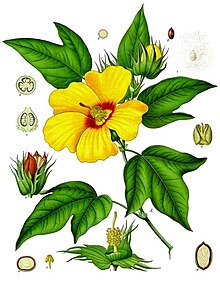Gossypium barbadense
| South American Cotton | |
|---|---|

| |
| Scientific classification | |
| Kingdom: | |
| (unranked): | |
| (unranked): | |
| (unranked): | |
| Order: | |
| Family: | |
| Genus: | |
| Species: | G. barbadense
|
| Binomial name | |
| Gossypium barbadense | |
Pima cotton (Gossypium barbadense), also known as Extra Long Staple, South American, Creole, Sea Island cotton, Egyptian, Algodon pais, and West Indische katoen, is a species of cotton plant . It is a tropical perennial plant that produces yellow flowers and has black seeds. It grows as a small, bushy tree and yields cotton with unusually long, silky fibers. In order to grow, it requires full sun and high humidity and rainfall. G. barbadense is also very sensitive to frost.
This plant has antifungal properties and contains the chemical gossypol, making it less susceptible to insect damage. It is also sometimes used as an anti-fertility drug. In Suriname’s traditional medicine, the leaves of G. barbadense are used to treat hypertension and delayed/irregular menstruation.
History
The name Pima was applied in honor of the Pima Indians who helped raise the cotton on USDA experimental farms in Arizona in the early 1900s.[1] The first clear sign of domestication of this cotton species comes from Ancon, a site on the Peruvian coast where cotton bolls dating to 4200 BC were found. By 1000 BC Peruvian cotton bolls were indistinguishable from modern cultivars of G. barbadense. Cotton growing became widespread in South America and spread to the West Indies where Christopher Columbus came across it. Cotton became a commercial slave plantation crop in the West Indies so that by the 1650’s Barbados had become the first British West Indian colony to export cotton.
Sea Island Cotton
In about 1786, planting of Sea Island Cotton, G. barbadense, began in the British North American colonies, on the Sea Islands of Georgia when cotton planters were brought over from Barbados.[2] (Among the earliest planters of Sea Island cotton in America was an Englishman, Francis Levett, who later fled his Georgia Plantation at the outbreak of the American Revolution and went to the Bahamas, where he attempted to introduce cotton production but failed.) Sea Island cotton commanded the highest price of all the cottons, due to its long staple 1½ in to 2½ in and its silky texture, it was used for the finest cotton counts and often mixed with silk. It was also grown on the uplands of Georgia where the quality was not so good[2], and was soon surpassed in commercial production by another native American species, Upland cotton (Gossypium hirsutum) which today represents about 95% of U.S production.
Egyptian Cotton
The term Egyptian cotton is usually applied to the extra long staple cotton produced in Egypt and used by luxury and upmarket brands worldwide. In fact, the cotton species which produces extra long staple "Egyptian" cotton is the native American species Gossypium barbadense which was introduced by Mohammad Ali Pasha in the 19th century. During the cotton famine caused by the American Civil War, Egyptian-grown cotton was promoted and received much investment, becoming a preferred alternate source for British textile mills. Indian surat cotton could only be used for coarse counts and would not spin on the existing machinery. Most of what is labeled "Egyptian cotton" today, however, also includes long staple cotton, the product of the other native American species Gossypium hirsutum [1]. The ancient Egyptians made their clothing from linen, a product of the flax plant.
United States agricultural policy
American Pima accounts for less than 5% of U.S. cotton production. It is grown chiefly in California, with small acreages in west Texas, New Mexico and Arizona.[1]
For purposes of federal support, the 2002 farm bill (P.L. 101-171, Sec. 1001) defines ELS cotton.
ELS cotton, like upland cotton, is eligible for marketing assistance loans and loan deficiency payments (LDPs). The national loan rate for ELS cotton under the 2002 farm bill is $0.7977 per pound. ELS cotton, in contrast to upland cotton, does not qualify for direct payments or counter-cyclical payments.[1]
References
- Sauer, J.D. 1993. Historical geography of crop plants - a select roster. CRC Press, Boca Raton, Florida.
- ^ a b c CRS Report for Congress: Agriculture: A Glossary of Terms, Programs, and Laws, 2005 Edition -Order Code 97-905
- ^ a b Cotton Year Book 1910, Textile Mercury Annual, 1910, Manchester
